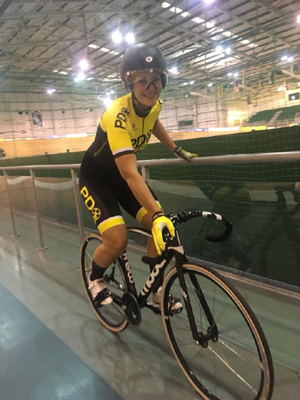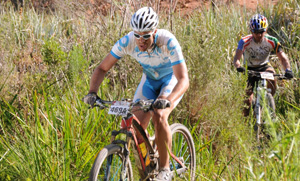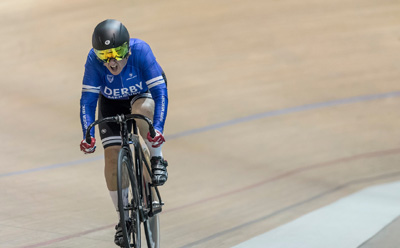There is no one-size-fits-all advice for older riders
[A version of this article was first published in Cycling Weekly on Nov. 27th 2018]
It’s a common assumption that as we age we grow less competitive. But, as with other outdated prejudices, this attitude is gradually giving way to the recognition that it is neither eccentric nor ill-advised to remain a racer decades after our prime years have passed. Training for performance should, of course, be adjusted to suit your age.
The difficulty, however, is there is no one-size-fits-all advice for older riders and we are an especially diverse bunch, with a huge range of lifestyles, sporting backgrounds, goals, and states of health and fitness.
As a coach specialising in maximising the performance of older riders, I am especially interested in the human stories: every enquiry that comes my way has an interesting story, along with hopes and ambitions. It’s my job to find their best pathway towards better performance and that is different for each rider.
To illustrate the diversity among older riders, I have depicted below some masters category archetypes and show how the route to peak performance depends on each individual’s unique set of traits and motivations.
Of course, no rider fits a single ‘type’ perfectly and each of us have the characteristics of a few. However, we will have key themes in common with one or two of the types. Let’s meet our willing participants and see what we can learn from them.
1. The Old Dog
Everyone knows an ‘old dog’: the type of rider who has been riding for years and is determined to stick to the same old-school methods. They spin the small ring till spring and then get form from training and racing hard — all the time. The old dog’s main measure of commitment is hours in the saddle per week and miles per year — as many as possible.
As the old dog begins to decline with age, they finally face the prospect of being ‘over the hill’. Some want to stay in the game and wonder if it is time to learn new tricks and get to grips with ‘modern methods’. Contrary to the proverb, they can be taught. It may be time to consider new horizons and goals.
Alan Dunlea, 44, is a toolmaker from Co. Clare
I’m not a typical Old Dog as I’m only cycling four years but I identify mostly with this type as I go hard and fast for as long as I can without any concession to my age.
I used to smoke and play golf obsessively until a buddy persuaded me to go for a spin, and I quickly fell down the cycling rabbit hole. I started casually riding with my wife and friends, progressed to getting hammered in club rides, and then to being dropped in Cat 4 races. I spent every night during the next winter kicking myself up and down hills and falling in the door cramping up. I started getting points the following season — my best result was third in a stage of a three-day, and I was upgraded to Cat 3.
My only strategy is to suffer. In a break, I’ll be the idiot doing the turn the other guy missed, and it’s a club joke that I’m the donkey for hire in the bunch. My short-term aim is to get upgraded to Cat 2; in the longer term, to win an M50 national championship. I’d also love to win at least one race.
Coach’s comments:
With the ageing effect beginning to bite at 44, Alan’s rapid progression will slow. If he continues in his current mindset, the point will come when he starts going backwards — sooner than necessary. If he is serious about achieving a race win he needs to get coaching advice and train with more structure and specificity appropriate to his age. Similarly, in racing, he needs to act less on impulse and more on intelligence – to take more shelter and then making his efforts really count at key moments.
If you identify with Alan, consider doing the following:
- Training and racing to a plan may diminish your sense of spontaneity and fun but will increase your chances of strong results — it’s your choice!
- Undertake a strength training programme, working on and off the bike to preserve declining muscle mass and develop sprint-specific strength.
- Reduce volume, and ensure your recovery is age-appropriate allowing you to hit the numbers in every key workout.
- Taper properly for targeted events.
- Race strategically, taking as much cover as possible from other riders to preserve yourself for the sprint.
2. The Newbie
The typical newbie masters rider has a background in sport that was disrupted by the demands of a social life, career, growing family, or injury. Then they were drawn into cycling and quickly fell in love with it but soon wanted to get faster, often aspiring to hang on to the front group.
Then the newbie begins to target events: a century or a trip to the Alps, eager to improve by leaps and bounds. Meanwhile, they feel bombarded by conflicting and confusing advice from friends, magazines and the internet, ending up feeling helpless: “A club-mate told me I’d save 10 watts per tyre if I changed from brand A to brand B.” They seek a clear, structured pathway to getting faster in the limited time available.
Amanda Karlsson, 50, is a police officer from Gloucestershire
I’ve always considered myself sporty and competed at senior county level in squash and hockey. Later, I circuit-trained and ran until back surgery put a stop to it. So I bought a second-hand bike in 2014 and joined a women’s cycling group to keep fit. I gradually gained in confidence and mileage and, after completing Ride London in 2016, I decided to try racing.
I’m competitive and, turning 50, keen to test myself against others. I bought a race bike and got a coach but was still lapped four times in my first event at Shrewsbury circuit in 2017. I was disappointed and lamented the poor availability of female masters racing. Even so, I persevered and tried Cat 4. Eventually, I stopped being dropped and eventually won points and got upgraded.
Winter training on the turbo last year seemed relentless, and a colleague suggested I try Newport velodrome. Everything was new and scary: gate-starts, sprint tactics and 42-degree banking. But the thrill and the challenge was addictive. I switched to a track coach, invested in a bike and all the kit, and did the British Cycling National Masters Track Championships in June, which I really enjoyed.
Now I’ve decided to focus on preparation for the World Masters Track Championship in Manchester in October 2019. I’d love to give it that one good shot, and I want to stay track racing into my 60s and be competitive at national level.
Coach’s comments:
Amanda’s entry into competitive cycling is similar to that of many masters riders who take up cycling for fitness for other sports, or to recover from injury. Amanda’s tenacity is an example to others seeking to improve performance: if you want to move to ‘the next level’ you have to be prepared to take a kicking, move on and learn from it.
If you identify with Amanda, consider doing the following:
- Explore different aspects of cycling to discover what enthuses you most.
- Use disappointing performances to positively re-evaluate your direction and progress.
- Seek the company of experienced, sensible riders to mentor you.
- Find a supportive coach who respects masters’ aspirations, to structure your training.
- Remember, it takes a number of years for a newbie older rider’s body to become fully conditioned — identify a long-term goal, plan multi-annually and work strategically towards it.
3. The Type-A
The typical Type-A rider is accomplished, refuses to settle for mediocrity and is in a hurry. They set ambitious goals, often targeting high-profile ‘bucket-list’ events. This type of rider is confident and applies target-focused, strategic approaches, often investing heavily in costly support services and equipment.
Many are high achievers in their work life and working methodically towards a goal, through a structured plan, comes naturally to them. They are easy to coach once they buy into the strategy and communicate well, asking pertinent questions and giving good feedback.
However, they can also be vulnerable to injury if relatively new to the sport by being in too much of a hurry and not giving their bodies time to adapt.
Paul Davies, 43, is a financial adviser and analyst from the Peak District
Sport has always been important to me. I’ve clocked up three black belts in martial arts, won an American football scholarship, raced Xterra [off-road triathlon] to world championship level and achieved top-10 in National Masters Cyclo-cross and top-15 in MTB Marathon — among other things.
My work is demanding but I can get in 15-20 hours training a week when needed. My last big event was the Wines2Whales three-day MTB race in South Africa in 2016. I came 12th out of 650 starters, in spite of lots of mechanicals and badly interrupted training from arthritis. I’ve been hampered by joint injuries from my younger years, which came to a head in 2017 when I had to have both hips re-surfaced, a specialist procedure. It was a dark time but my rehab goal was to go back to the Wines2Whales in November 2018.
I’m very target-driven and worked with highly experienced physio and rehab specialists, building my form gradually. I used Manchester velodrome for very specific workouts. My 20-minute power came back to around 400 watts. Working with a leading sports psychologist was very helpful and I got back to a happy place, riding my bike and aiming to compete at the top level.
I did make it back to Wines2Whales earlier this month and came 10th in the Vets category and 45th overall out of a field of 604 racers. I was happy with that after nine-and-a-half hour’s racing.
Coach’s comments:
Many Type-As discover cycling in their masters years and, like Paul, quickly become very focused and ambitious. Paul is especially high-achieving; many others take on less epic but still very demanding sportive-type events such as the Majorca 312 Gran Fondo or the Marmotte.
If you identify with Paul, consider doing the following:
- If you are relatively new to cycling, learn how to avoid injuring yourself — your body may be relatively unconditioned and may not initially stand up to your ambitions.
- Incorporate the necessary ‘scaffolding’ into your plan: strength, flexibility, bike-fit, and weight management.
- Be realistic about your schedule – can you really manage 15 hours’ training – and work with a coach to build an optimised programme, planned around your work and life demands.
- Along with the physiological development, refine your nutrition and pacing strategies — this is critical for less experienced riders taking on long, demanding events.
4. The Now-Or-Never
Now-Or-Never riders have never fully committed to their sport and have been left with a nagging question: ‘what if?’
There are myriad reasons for having left it so long: career, family, or perhaps just lack of application. Some are plagued by feelings of inadequacy and self-doubt, fearful of not matching up to their own or others’ expectations: they were fearful of being a failure.
Then the realisation hits: ‘it’s now or never’ and want to give it one last go and make an all-out attempt to become a ‘proper athlete’ and finally see how far they can get.
Alison Salthouse, 59, is a civil servant from Shropshire
I had my first now-or-never moment aged 53, when my dad died; I remembered that he’d had a stroke aged 50. I bought a hybrid bike to get in shape, but was shocked when I found myself out of breath after half a mile.
I found a group of social cyclists and met a guy who took me out for three-, then five-, then 10-mile rides. I entered my first sportive — 13 miles — and that was the real beginning. I progressed to doing some big sportives and tried mountain biking and BMX. I had always dreamed of being good at something sporty, so I tried a crit but got lapped by girls young enough to be my daughters.
In 2015 I discovered the exhilaration of track cycling, which triggered my second now-or-never moment. I had found my sport and realised I could have one last chance of being a competitive sportsperson. I initially found it hard to get a coach — many seemed put off by my age and lack of a sporting background.
It has been an uphill struggle but I persevered and now have a coach who believes in me. I am faster, thinner and stronger. This year I competed in the LVRC national track championships and came fourth in the 500TT and Match Sprint — inches from the podium. I began to believe I can really achieve.
Next year I am aiming to podium in the 60-64 group at the World Masters Track Championships to celebrate my 60th! It’s been hard, of course, but for the first time in my life I love telling people my age and am looking forward to being that year older and in another masters category. I am now proud of who I am.
Coach’s comments:
Alison is a textbook example of how a now-or-never cyclist can eventually live the dream. She started gradually, explored various aspects of the sport and discovered which discipline enthused her the most. Next, she found expert guidance and then set clear goals. It is still early days for Alison but, by avoiding injury or ill-health, she can look forward to steady improvement and chasing world-class dreams into the 60-64 category and beyond.
If you identify with Alison, consider doing the following:
- Undertake weight training to re-build the strength critical for your target event and which may have been diminished by decades of inactivity.
- Training specificity for your target event — for example, high-cadence speed intervals.
- Prioritise your weaknesses, such as standing starts.
- Adjust the load-recovery cycle in a way appropriate for your age and the intensity of your training.
How to Train for your Age
(for more detailed information see my four-part series here …)
As we age, our maximal aerobic capacity (VO2 Max) and anaerobic threshold gradually declines, as does our muscle mass. The good news is, this deterioration can be significantly slowed down by doing regular high-intensity and threshold sessions all year round. These are the key principles to address:
- Loss of muscle mass with ageing is greatly reduced with regular strength training that primarily targets the legs and glutes, such as squats, lunges, step-ups and single-leg split squats and deadlifts. Three to five sets of 10-15 repetitions are generally recommended but, like all training, the load would ideally be adjusted to suit your fitness and the time in your training cycle.
- There is a progressive need for more recovery from hard sessions as you get older — this is a cornerstone of performance. A 45 year-old, for example, might get away with one day’s recovery after a hard session, while 55-year old might need two and a 65 year-old might need three.
- Make time for regular ‘maintenance’ and ‘scaffolding’ sessions (e.g. stretching, foam rolling, strength) help with long-term suppleness and mobility.
- Eat sensibly, avoiding sugar spikes that can lead to poor insulin sensitivity and increased belly-fat.
- Adequate protein is also important in our normal diet and recommendations for masters athletes vary between 1 and 1.5 gms. per kg. per day, spread out as regularly as possible. Good sources include lean meats and fish, eggs, dairy, and nuts and seeds. Supplementation, in the form of a recovery drink, is recommended immediately after high intensity sessions (usually 25 gms. approx. per portion).
- Do everything you can to sleep well. Sleep is the best supplement for hard training.
- Train smart with a plan matched to your goal and lifestyle, and which prioritises consistency, progression and recovery.




